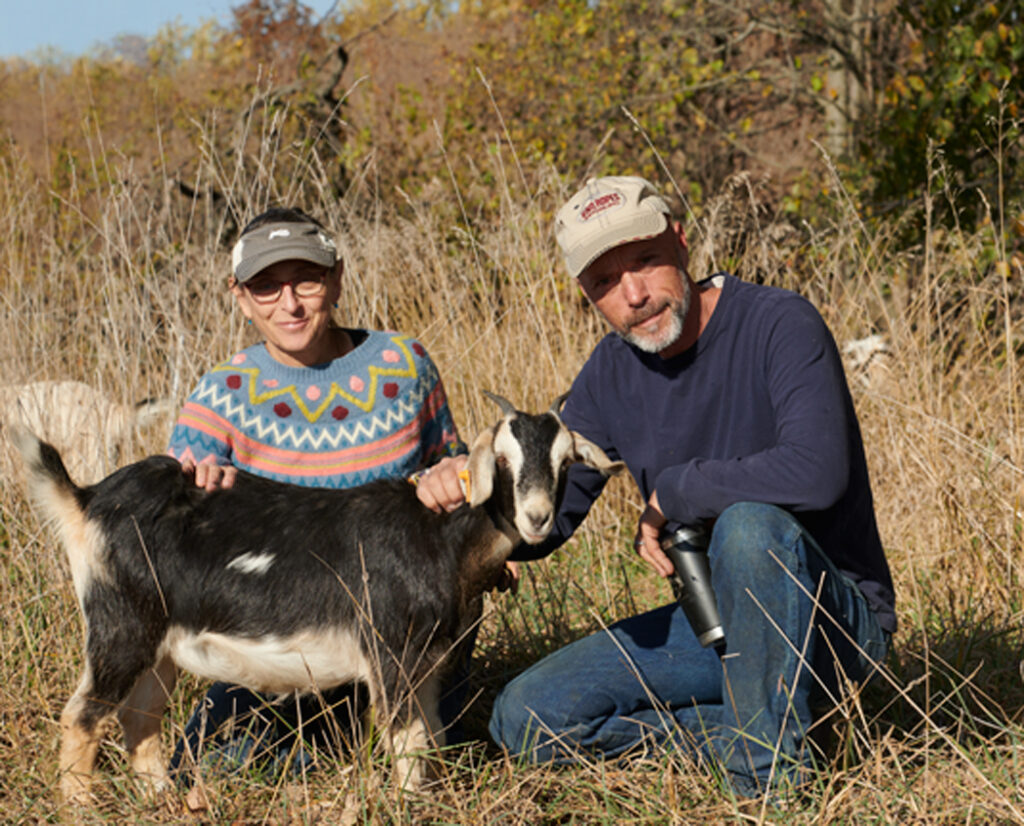
I’m one of those people who need to be in denial about what meat is in order to eat it. The closest I usually get to relating to the animal that’s soon to become my dinner is reading words on the package. “Grass-fed,” “free-range,” and “antibiotic free” are words that make me feel slightly better about my choice. I want to believe the animals had access to fresh air and sunshine and green things and even to their own mothers. But I draw the line at meeting the actual chicken. Or lobster. Or pig. I have no problem extinguishing a head of lettuce or a potato, but if it’s a turkey, please don’t make me think too hard about it. Just shut up and pass the gravy.
My particular brand of avoidance is why, I’ll fully admit, my planned visit to Whippoorwill Creek Farm last month had me anxious. I was going to meet a herd of cattle. I was going to taste some grass-finished beef. I was going to wrestle with my own conscience for the day.
But maybe that’s one of the healthiest things a person can do. Reckon with the source of their food.
Thinking about the source of their food is partially what motivated Beth Hoffman and her husband John Hogeland to relocate from the San Francisco Bay area back to Hogeland’s family farm in Iowa six years ago to make a go of it, joining a growing number of farmers and ranchers who are passionate about providing Iowans with nutrient-rich, organic ingredients that didn’t arrive via semi-truck from Texas or wherever.
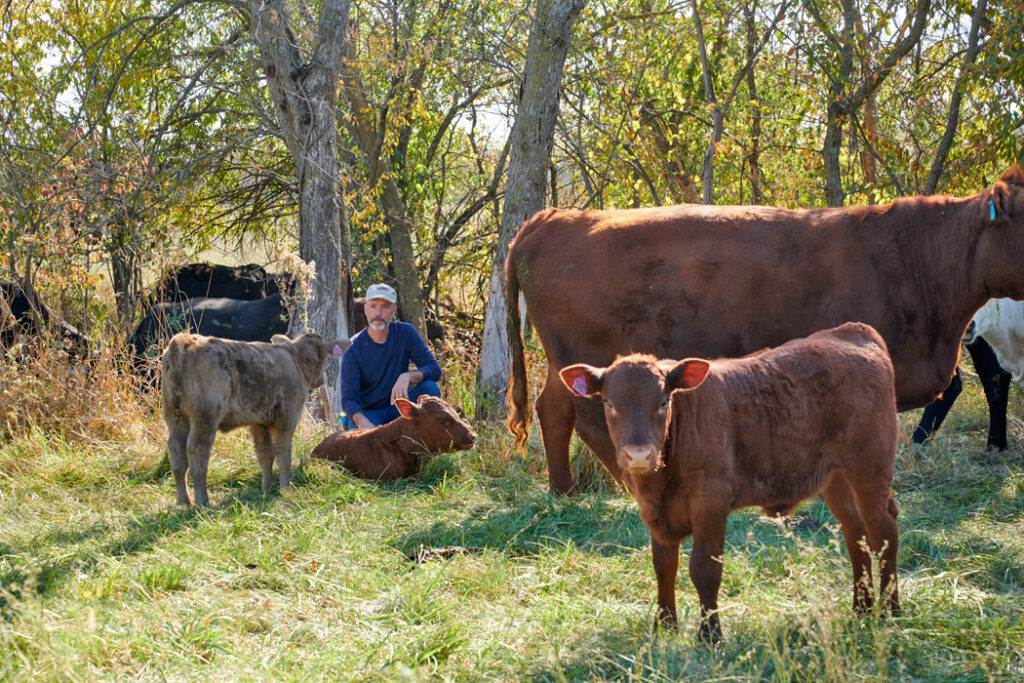
After pivoting from his career in the culinary arts, John Hogeland is now a fifth-generation farmer on his family’s 600 acres of land outside Lovilia, Iowa, just northwest of Ottumwa. Beth Hoffman is a former Berkeley professor, a food and agricultural reporter with an international resume, and the author of a recently published memoir, Bet the Farm: The Dollars and Sense of Growing Food in America. The pair is now braiding their gifts together at Whippoorwill Creek Farm, not only raising cattle and goats for meat, but also hosting classes, gatherings, tastings, community meals, and even writing workshops, as well as providing land for a handful of others to work their own gardens and microfarms.
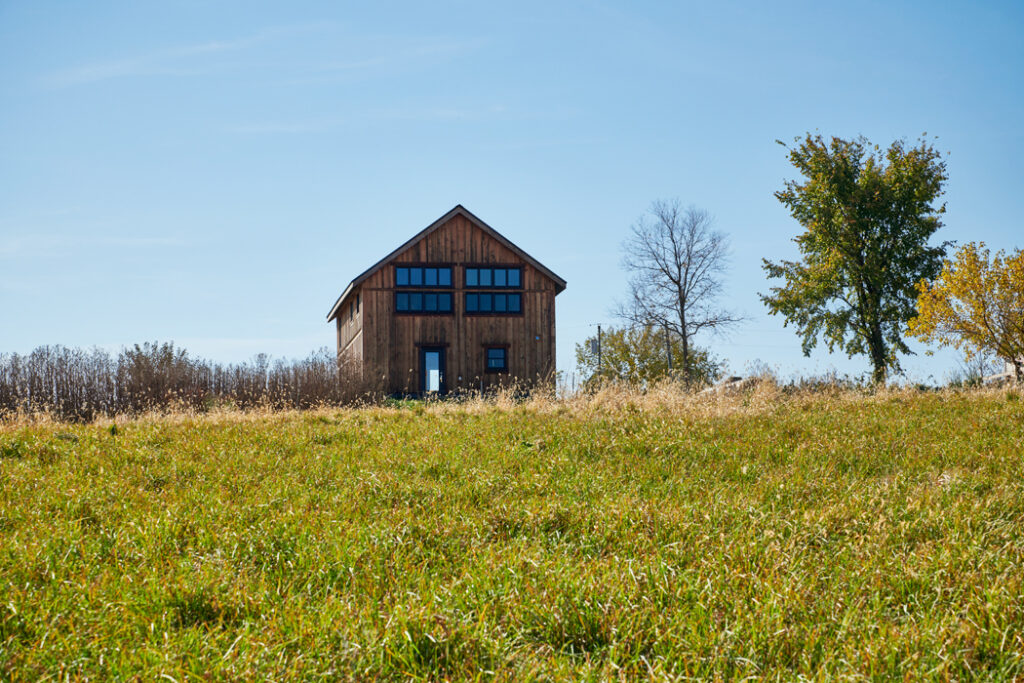
Beth and John’s blue hilltop farmhouse, congenially guarded by several dogs, cats, ducks, and chickens, sits high along an exceptionally pretty gravel drive. Steps away, their newly restored “barn” is home to a welcoming state-of-the-art kitchen, cooking-demo space, and community dining room, while the barn’s top floor serves as a charming Airbnb. Rustic-chic decor and furnishings—partially sourced from salvaged panels and the farm’s own timbers—make for cozy but spotlessly clean indoor spaces, while the vegetable gardens, rolling pasturelands, and forested acres of their farm and neighboring lands offer a stunning view across the valley.
The timing of my visit lined up with one of the farm’s special events, the “Grass vs. Corn Showdown,” where I joined a small group of foodies, food growers, and a couple other journalists for a farm tour and grass- and grain-finished beef tastings.
The crew was treated to 70 degrees and breezy sunshine as John, Beth, and hired farmer Jacob Chambers—an expert in his own right—led us downhill through grassy pastures, familiarizing us with the terrain and taking turns describing the care of the crops, the animals, and the land—things that on their farm go inextricably hand in hand. They spoke about managing the grazing patterns of the goats and cattle in order to maximize the propagation of grasses, plants, and trees the animals can and like to feed on, while minimizing some of the aggressive species that crowd out more valuable grasses and beneficial weeds. Their cows and goats make a good duo in rotation, often making use of different plants. Cattle avoid the invasive multiflora rose, for instance, “but put goats near a mutliflora rose, and that’s the first thing they’ll eat,” says John.
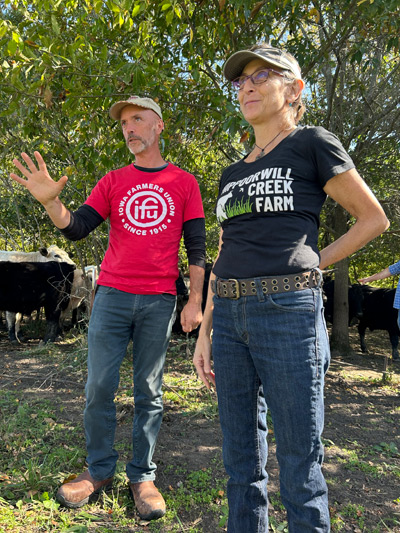
One of the farm’s ongoing projects is cultivating the forested areas—and accompanying forest crops—that provide natural shelter and shade for the animals. As we neared a stand of trees along the border of the acreage, one of the herds came tumbling out of the woods together, stopping in a curious lineup at the edge of the shade to inspect us. I’d never been that close to a yearling before—without a fence in between. John knelt down, and the leader of the pack, pure black, ventured close enough to lick his hand.
Every “fat calf” in the herd was a different color than the next, from white to red to grey. Some had sleek hair, others curly. Beth explained that they breed the cows that have favorable characteristics; some calves prove to be naturally more fly resistant (akin to a human who doesn’t attract mosquitos), and some breeds are less susceptible to heat. They pay close attention to the yearlings who have promising features—short and stocky with a big barrel is ideal. “And I don’t keep any cattle that are mean,” says John. He’s hoping his favorite cow—an affectionate, mild-mannered Hereford cross, named Red—will have lots of babies.
Learning throughout the afternoon about what all the cattle were eating was more interesting than I would have expected. Their October menu included a variety of cool-season grasses that had now taken over for the warm-season bunch grasses—some of them native, and others, bluegrasses and fescues, planted by John’s father before his passing. The herds were soon to be treated to a verdant pasture laden with purple clover and the occasional aster. By design, the clover blooms had been left alone just long enough to produce viable seeds that would “pass right through into the cow pie” and provide new plants the following season.
For much of the year, the maturing calves also have access to a pharmacy of “medicinal” trees bearing leaves they instinctively know to nibble on when they’ve got a “stomachache or are feeling wormy,” says John. The arsenides in the black cherry tree, for instance, and the tannins in the leaves of an oak work their own magic.
It didn’t sink in how the variety of foods the cattle were offered would translate to a freshly cooked steak—until I tasted it. First of all, let me just say that John knows what he’s doing on the grill; the samples we tried—two different cuts of grain-finished beef from HyVee, and the same two cuts of beef from his ranch—were all delicious. Some of the best I’ve had. I’d be hard pressed to pick a favorite. But running the risk of sounding like a commercial, I was struck by the depth and complexity of flavor from the Whippoorwill Creek steak, something I can only liken to tasting good wine. Replace, for example, “a fruit-forward bouquet, muscular mouthfeel, and notes of citrus and oak,” with “a juicy, tender steak with notes of purple clover, Eastern gamagrass, and a black cherry finish.” I’m sorta kidding, but sorta not. And it’s a weird thing to say, but I swear I could taste the green.

“When you drive around anywhere in the U.S. and see cows out,” says Beth during a quick visit to meet some of the unweaned calves and their mothers, “there’s lots of them grazing, but most of [these ranches] are doing what’s called a cow/calf operation where the cows have calves out there, they graze, but within about nine months those calves are brought into feedlots.” At that point they’re fed a grain diet, typically corn and soybeans. “Growing all that corn and beans makes for a heavy input system where you’re putting in a lot of fertilizer, a lot of herbicides, a lot of intensity—a lot of fossil fuels to do all the seeding and the harvesting. And it also has really heavy implications on the animals—they have a really hard time processing that kind of diet.” Most cattle are then fed antibiotics, she explains, “to keep their bellies able to deal with all of the stuff they don’t normally eat.”
John adds, “I liken it to sitting on the couch and eating Twinkies all day. That’s basically what it is: they get sugar into ’em so they grow, and get as much fat into them. You can imagine if you sat on the couch for six to eight months doing nothing but eating donuts and cookies, what that would do to your health. You’d need antibiotics as well!”
“By comparison,” says Beth, “when animals stay here their whole lives, it can take a lot longer because they’re not getting that intense diet, they’re moving each day, and they grow slower. But what we see is that the fats are super different between raising animals this way,” she gestures to her pasture, “and getting them as fat as you can as quickly as possible. It’s a very different feel to being in a feedlot literally standing in your shit all the time, and eating what you shouldn’t be eating.”
Whippoorwill Creek Farm was chosen to be part of a recent Bionutrient Institute study analyzing, among other things, the correlation between the diversity of plants that cattle are raised on and the resulting ratios of Omega-6 to Omega-3—forms of beneficial fats and essential fatty acids that we, as humans, don’t produce ourselves, so must consume in our diets. But when it comes to Omega-6, the “too much of a good thing” rule applies. For optimal health, “a lower ratio is what we want,” says Beth. According to the Bionutrient Institute, common grain-fed beef has a ratio of 7:1 or higher, while grass-fed beef typically averages around 3:1, which is considered to be within the healthy range (4:1 or lower). Extensive soil, manure, and plant samples taken from Whippoorwill Creek Farm convey a wide range of forage. And samples of their beef were found to have an Omega 6:3 ratio of 1:1. The study is finding that a wider range of forage means healthier meat.

And it counts to read labels. Sometimes a “grass-fed” label means the calves “had access” to grass but doesn’t guarantee they ate much of it. Or sometimes it means they were raised entirely on only one type of green, like alfalfa, which is also not ideal. Providing their herds with a rotating diet of 60–70 different plant species, Whippoorwill Creek Farm proudly calls their beef “grass-fed and grass-finished.”
“That said,” Beth explains, “we try not to oversell. Because corn-fed beef tastes good! But there’s so much more to it than that.”
Whippoorwill Creek Farm has chosen a direct-market sales model, because “when you’re in the commodity market,” says Beth, “you don’t get to set your prices.” For a time- and labor-intensive operation like theirs, it’s important that they’re able to decide for themselves what their products are worth.
This work is clearly in John’s blood, in his roots, in this very piece of land. But for Beth, I was still wanting to understand why she was up for leaving California behind to work a farm—in Iowa.
Just as she hopes her memoir, Bet the Farm—in which she writes firsthand about the challenges of farming and the perils of the system—will continue to inform, entertain, and inspire readers, Beth tells me she herself was energized by a book she randomly picked up from a Little Free Library in front of somebody’s house, called How to Be Danish, of all things.
“There’s a chapter about food,” she explains. “Apparently the Danish diet was awful—they were importing everything, and everything was super overprocessed, with whole generations being raised on this lousy food. And people got together—chefs and changemakers, I guess you’d say—and they made a manifesto, the New Nordic Food manifesto, it’s called. The manifesto was about changing the culture of food” and establishing a system of food they want to be known for. Their region is “full of forests with edible food,” says Beth, “a huge coastline full of delicious seafood, farms, great soil.
“And I kinda feel like we’re just at this moment in Iowa where we have a system that’s largely not working for people. Environmentally, it has a lot of serious repercussions, and financially. Like this year and the coming years are supposed to be terrible for Iowa farms—corn and soybean prices will be super low. And the way most people are thinking about it is, ‘We gotta get the price supports to be higher, and the Farm Bill, and more crop insurance,’ and more of the same. But couldn’t we shift gears? Wouldn’t this be a time where you could convince people? Do farmers really want to just be dependent on the government for years and years and years?”
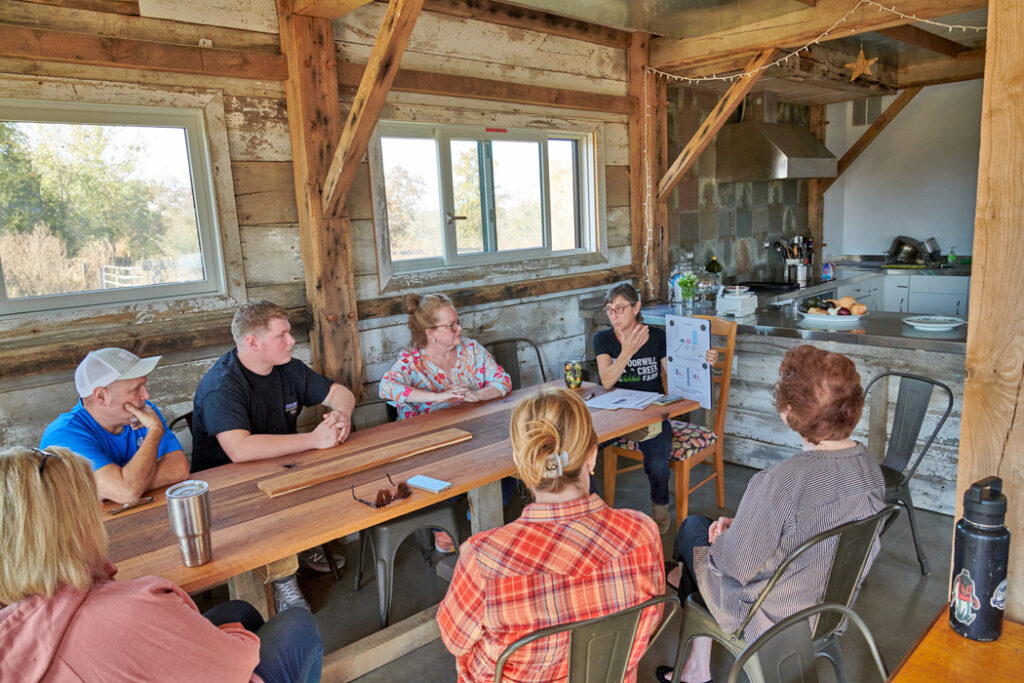
For Beth, the most important thing they do at their farm is bring people in, share with visitors what they’re up to, and serve up some great food. High-quality meat from healthy animals, organic grains, fresh vegetables, all grown right there. She hopes the takeaway will be “that all of this food has flavor on your plate, it all comes out of the garden, and it’s not that far-fetched for us all to eat like this all the time.”
“I was at Hy-Vee yesterday in Des Moines,” Beth says, “this huuuuuge produce section, and asked if there was anything from Iowa.” She was directed toward some squash, but was saddened not to find a single Iowa apple. “We have great apples here. Our neighbors are growing these apples that are spectacular!”
“Iowa agriculture could be so much more,” she says. “Could we also be known for the best? Not just the most? It would revolutionize our state if we put a focus on ‘let’s have the best.’ Let’s grow a variety of things, let’s give farmers lots of opportunity—it might not be the cheapest, right? But at the end of the day, how do we want other people to think about us? Our rap outside of this state is: Corn. Cancer. We want them to turn around and be like, ‘Iowa. Awesome!’”
Go for a drive and visit Whippoorwill Creek Farm. Admire the beautiful view. Take a tour. Bring the kids. Meet the animals. Sign up for a class. Stay the night. And get a little taste of awesome.
It’s been weeks since my visit, and I’m still thinking about my food. Not just about what more I could grow. But where I want my food dollars to go.
